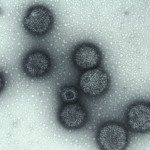Nanopore sequencing of a monkeypox virus strain isolated from a pustular lesion in the Central African Republic
Monkeypox is an emerging and neglected zoonotic disease whose number of reported cases has been gradually increasing in Central Africa since 1980. This disease is caused by the monkeypox virus (MPXV), which belongs to the genus Orthopoxvirus in the family Poxviridae. Obtaining molecular data is particularly useful for establishing the relationships between the viral strains involved in outbreaks in countries affected by this disease. In this study, we evaluated the use of the MinION real-time sequencer as well as different polishing tools on MinION-sequenced genome for sequencing the MPXV genome originating from a pustular lesion in the context of an epidemic in a remote area of the Central African Republic. The reads corresponding to the MPXV genome were identified using two taxonomic classifiers, Kraken2 and Kaiju. Assembly of these reads led to a complete sequence of 196,956 bases, which is 6322 bases longer than the sequence previously obtained with Illumina sequencing from the same sample. The comparison of the two sequences showed mainly indels at the homopolymeric regions. However, the combined use of Canu with specific polishing tools such as Medaka and Homopolish was the best combination that reduced their numbers without adding mismatches. Although MinION sequencing is known to introduce a number of characteristic errors compared to Illumina sequencing, the new polishing tools allow a better-quality MinION-sequenced genome, thus to be used to help determine strain origin through phylogenetic analysis.
https://www.nature.com/articles/s41598-022-15073-1





